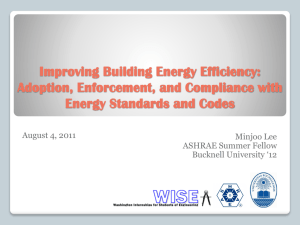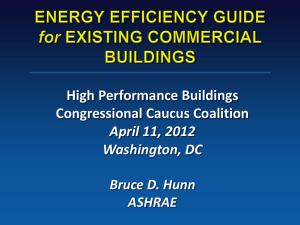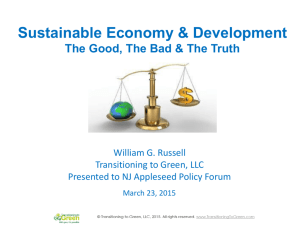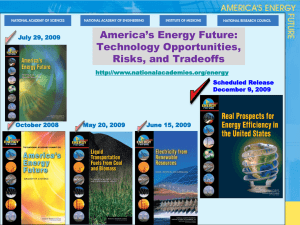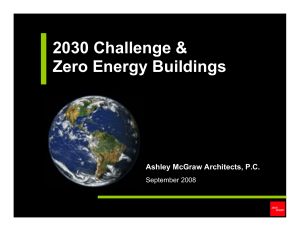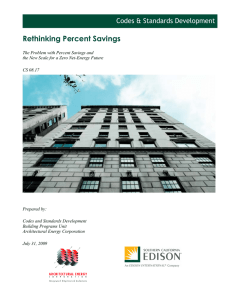February 2009 Program: The Path to Net Zero Energy Buildings by
advertisement
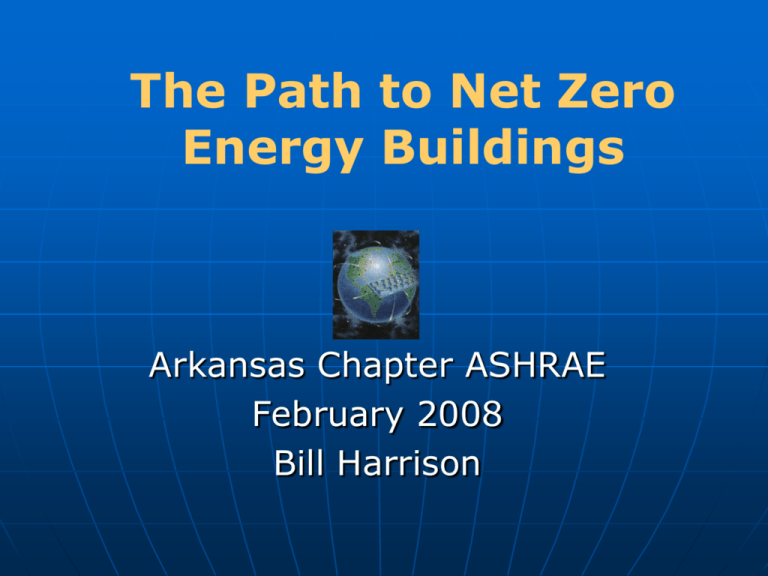
The Path to Net Zero Energy Buildings Arkansas Chapter ASHRAE February 2008 Bill Harrison Total Energy Consumption United States Industrial 32% Transportation 28% Buildings 40% World Marketed Energy Consumption Quadrillion Btu History Projections Source: Energy Information Administration (EIA), International Energy Annual Report 2004 Global Energy Consumption 5 4.52 4 2.96 2.7 3 TW 2 1.21 0.828 1 0.286 0.286 0 Oil Coal Gas Total: 12.8 TW Biomass Hydro Nuclear Renew U.S.: 3.3 TW (99 Quads) The Rising Cost of Oil 100 80 60 40 20 0 $ Per Barrel 1960 1991 2005 1970 1996 2007 1974 2000 2008 World Energy Consumption Net-Zero-Energy Buildings Buildings which, on an annual basis, use no more energy than is provided by on-site renewable energy sources. Energy Terms Energy Use Intensity: BTU/Sq. Ft./Year CBECS: Commercial Building Energy Consumption Survey DOE Determination: Modeled predicted performance of a building designed in compliance with ASHRAE Std. 90.1 Site versus Source CBECS Commercial Buildings Energy Consumption Survey Snapshot of entire commercial sector as of a certain date (done every 4 years— 1999, 2003, 2007) Data masked to protect privacy—no real locations, no real areas, skewed number of floors Lots of detail about building composition (but it is self-reported) Relative EUI Values All are “site” values in BTU / Square Foot / Year 91,000: 2003 CBECS data 47,000 - 50,000: Probable 90.12004 Determination Number 36,000: Target for 90.1-2010 25,000: Energy Efficient Building 0: Net Zero Energy Building Requires renewable energy (PV, Wind) Energy Reduction Proposal Energy (kBtu/yr) 36000 Standard 90.1 AEDG ASHRAE BOD Goal Standard 189 2010 2015 2020 Year 2025 2030 Implications for Building Designers Absolute requirement to incorporate energy efficiency into all of our designs Better use of tools to predict energy use in buildings Use of life cycle costing Learning to communicate the message to owners and their agents Architecture 2030 Challenge Architecture 2030 Challenge target: in 2007 all new buildings and major renovations shall be designed to use 50% of the regional average for that building type, on fossil fuel reduction basis (2030 is on carbon basis) Target increases to 60% in 2010 and by 10% for each 5 years thereafter until in 2030 all new and renovated building designs will be carbon neutral (using no net fossil fuel energy to operate) AIA Green Building Coalition 100 Adopted the Architecture 2030 Challenge AIA U.S. Green Building Council ASHRAE Adopted CBECS Baseline 80 60 40 20 0 CBECS 2015 EUI 2030 Practical Energy Measures Building orientation Daylighting Improved envelope thermal performance Cool roof External overhang or shading Continuous air barrier Integrated Design Architect, HVAC, lighting and electrical, interior design, landscape architecture Establish energy budget during conceptual design phase of project Monitor energy impact of building decisions Future: Building Information Modeling Energy Modeling Manufacturers’ programs Energy Plus • www.eere.energy.gov/buildings/ener gyplus eQuest • www.doe2.com/equest/ DOE-2.1E • www.gundog.lbl.gov/dirsoft/d2whatis.html Reference Sources US Department of Energy • www.energy.gov National Renewable Energy Laboratory • Great case studies • www.nrel.gov EPA • www.epa.gov ASHRAE • www.engineeringforsustainability.org Case Study Buildings • Oberlin College Lewis Center Oberlin, Ohio goal: zero net site energy use (79%) • Zion Visitor Center Springdale, UT goal: 70% energy cost savings (65%) • Cambria Office Building Ebensburg, PA goal: 66% energy cost savings (43%) • Chesapeake Bay Foundation (CBF) Annapolis, MD goal: LEED 1.0 Platinum Rating (25%) • Thermal Test Facility (TTF) Golden, CO goal: 70% energy savings (51%) • BigHorn Home Improvement Silverthorne, CO goal: 60% energy cost savings (53%) • Science House, Science Museum of Minnesota St. Paul, Minnesota goal: zero net site energy use (139%) The Path to a Net Zero Building cash flow Lease Costs (or Finance Costs) Total Annual Costs ($/year) utility bills 1 2 0 0% 100% Source Energy Savings (%) Sustainability Standards 90.1-2010 – Prescriptive and Performance 189.1P – High Performance Green Buildings 189.2P – High Performance Green Healthcare Facilities 191P - Water Conservation Standard Advanced Energy Design Guides AEDG for K-12 School Buildings 30% savings over 90.11999 Distributed to 14,000 school administrators All AEDG available for free download www.ashrae.org ASHRAE GreenGuide Second Edition Step-by-step manual for the entire building lifecycle Construction, operation, maintenance, and eventual demolition Techniques applicable to related technical disciplines 29 "Green Tips" Case studies, checklists, and other practical information High Performing Buildings Launched November 2007 Case Studies Lessons Learned Hot and Humid Design Guide Published January 2008 First Edition Summary Energy Efficiency is imperative – set a target energy budget, talk about EUI Make energy modeling a standard step in design process – track EUI changes Communicate with owners and agents Document efficiency measures to transmit to building operators

